
The Curculionidae are the family of the "true" weevils. They are one of the largest animal families, with 6,800 genera and 83,000 species described worldwide. They are the sister group to the family Brentidae.
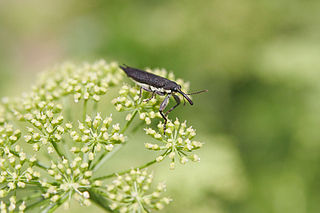
Weevils are beetles belonging to the superfamily Curculionoidea, known for their elongated snouts. They are usually small, less than 6 mm in length, and herbivorous. Approximately 97,000 species of weevils are known. They belong to several families, with most of them in the family Curculionidae. Some other beetles, although not closely related, bear the name "weevil", such as the biscuit weevil, which belongs to the family Ptinidae.

The palm weevil Rhynchophorus ferrugineus is one of two species of snout beetle known as the red palm weevil, Asian palm weevil or sago palm weevil. The adult beetles are relatively large, ranging between 2 and 4 centimetres long, and are usually a rusty red colour—but many colour variants exist and have often been classified as different species. Weevil larvae can excavate holes in the trunks of palm trees up to 1 metre (3.3 ft) long, thereby weakening and eventually killing the host plant. As a result, the weevil is considered a major pest in palm plantations, including the coconut palm, date palm and oil palm.

The New Zealand giraffe weevil, Lasiorhynchus barbicornis, is a distinctive straight-snouted weevil in the subfamily Brentinae, endemic to New Zealand. L. barbicornis is New Zealand's longest beetle, and shows extreme sexual dimorphism: males measure up to 90 mm, and females 50 mm, although there is an extreme range of body sizes in both sexes. In males the elongated snout can be nearly as long as the body. Male giraffe weevils use this long rostrum to battle over females, although small males can avoid conflict and 'sneak' in to mate with females, sometimes under the noses of large males. The larval weevils tunnel into wood for at least two years before emerging, and live for only a few weeks as adults.

Curculio nucum, the nut weevil, is a medium-sized beetle, with an especially elongated snout, characteristic of the Curculionini tribe of the weevil family (Curculionidae). Its larvae develop in hazel nuts Corylus avellana, being a serious pest in hazelnut orchards. It occurs in most of Europe, from south Sweden, Finland and Great Britain to the Mediterranean.

Otiorhynchus is a large genus of weevils in the family Curculionidae. Many species of the genus, particularly the black vine weevil and the strawberry root weevil, are important pests, both as larvae and as adults. Larvae feed on plant roots. Adults are flightless with fused elytra and feed at night on plant foliage. In many species of the genus at least some races are polyploid and parthenogenetic, while the rest of the races and species are diploid and bisexual. Otiorhynchus weevils, particularly O. scaber, have been a popular subject for studies of the evolution of parthenogenesis. The genus is native to the Palearctic region. However, sixteen species were inadvertently introduced to North America and have become widespread there.

The Entiminae are a large subfamily in the weevil family Curculionidae, containing most of the short-nosed weevils, including such genera as Entimus, Otiorhynchus, Phyllobius, Sitona, and Pachyrrhynchus. In comparison with their stunning diversity, only a few of these weevils are notorious pests of major economic importance. Entimines are commonly encountered in the field, including urban environments, and abundant in entomological collections.

Baridinae is a subfamily of true weevils (Curculionidae). It was established by Carl Johan Schönherr in 1836. Some 4,300 species in 550 genera are placed here, most of which occur in the New World. A few are economically significant pests, while others are in turn used for biocontrol of invasive plant pests. This subfamily also contains a few endangered species.

Naupactus is a genus of beetles in the weevil family Curculionidae, the true weevils. They are known commonly as whitefringed beetles. Many species of the genus are considered pests, both as larvae and as adults. The genus is native to the Americas, where it is distributed from Mexico to Argentina; the highest species diversity is in Brazil. Several species have been introduced to the United States and New Zealand.

Hadramphus, commonly known as knobbled weevils, is a genus of flightless molytine weevils from the family Curculionidae. It is endemic to New Zealand and consists of four species.
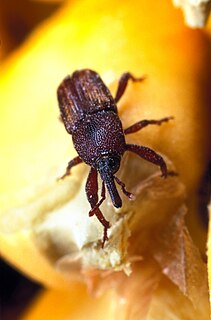
The maize weevil, known in the United States as the greater rice weevil, is a species of beetle in the family Curculionidae. It can be found in numerous tropical areas around the world, and in the United States, and is a major pest of maize. This species attacks both standing crops and stored cereal products, including wheat, rice, sorghum, oats, barley, rye, buckwheat, peas, and cottonseed. The maize weevil also infests other types of stored, processed cereal products such as pasta, cassava, and various coarse, milled grains. It has even been known to attack fruit while in storage, such as apples.
Austroplatypus incompertus is a species of ambrosia beetle belonging to the true weevil family, native to Australia, with a verified distribution in New South Wales and Victoria. It forms colonies in the heartwood of Eucalyptus trees and is the first beetle to be recognized as a eusocial insect. Austroplatypus incompertus is considered eusocial because groups contain a single fertilized female that is protected and taken care of by a small number of unfertilized females that also do much of the work. The species likely passed on cultivated fungi to other weevils.
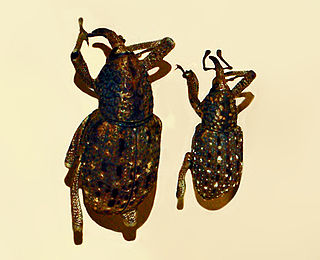
Sipalinus gigas is a species of beetles belonging to the family Curculionidae.
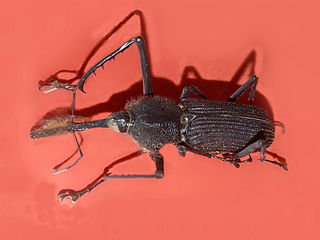
Rhinostomus barbirostris, common name Bottlebrush Weevil or Bearded Weevil, is a species of true weevil family.

Eustylini is a primarily Neotropical weevil tribe in the subfamily Entiminae.
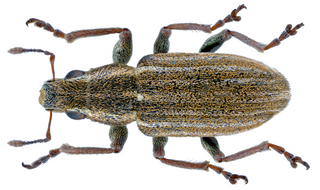
Sitona lineatus, commonly known as the pea leaf weevil is a species of weevil with a Palearctic distribution. It is a common pest of beans, peas, and other plants in the family Fabaceae. Adult beetles of S. lineatus measure 3.4-5.3 mm in length. They are characterized by a series of colored scales arranged in alternating lines (striae) on the elytra; it is from this characteristic where the species gets its name lineatus meaning 'lined' or 'striped'. The head and pronotum also have fine pointed setae amongst the scales. The antennae are clubbed, pointed and preceded by 7 segments. The femora is dark, but tibiae and tarsi are red. As a member of Order Coleoptera (beetles) their forewings are modified to form hardened covers over the thorax and abdomen, with the hindwings for flight underneath.

Metamasius callizona, or the Mexican bromeliad weevil, is in an invasive species in Florida, USA that targets several species of bromeliad. This species is native to southern Mexico, Guatemala, and Panama, and was first documented in Florida in 1989.

Larinus turbinatus is a species of true weevil in the family of beetles known as Curculionidae.

Lyperobius huttoni is a New Zealand weevil found in alpine areas of the South Island and at sea level around the Wellington coast. It feeds only on speargrass (Aciphylla). Weevils from the endangered Wellington population have been translocated to predator-free Mana Island.
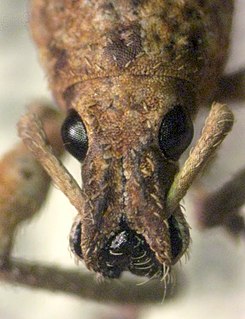
Brachyomus is a Neotropical genus of broad-nosed weevils in the subfamily Entiminae, tribe Eustylini.




















